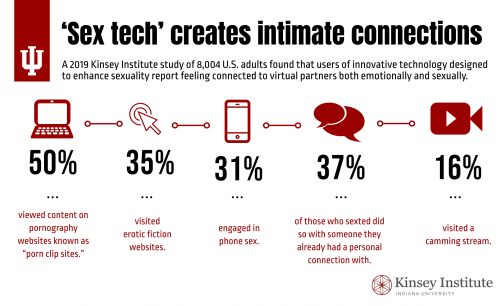
Education
'Sex Tech' Research Shows Technology makes sexual and emotional experiences simpler.

Advances in technology have allowed us to communicate with others across the globe, and a new study of adults engaged in sex technology — innovative technologies used to improve sexuality — announced by the Kinsey Institute at Indiana University shows that technology increasingly links people at their most intimate moments.
In an comprehensive survey of more than 8,000 Americans conducted at the end of 2019, Kinsey Institute researchers found that the use of sex technologies is on the rise and users report feeling linked to virtual partners both emotionally and sexually.
An underlying finding from the research showed that sex tech participants reported less loneliness and depression than those who did not interact with sex tech, but only those who felt an emotional or personal connection to their virtual partners.
Lower levels of isolation were also observed for people who had more optimistic attitudes towards their own sexuality, as was greater overall satisfaction with their lives.
Amanda Gesselman, Anita Aldrich Endowed Research Scientist and Associate Director of Research at the Kinsey Institute, said, Technology is becoming more prevalent in our romantic and sexual life, and we are beginning to gain a better understanding of the role of sex technology in our relationships and sexual experiences.
In the new report, 50 per cent of the participants viewed content on porn websites known as porn clip pages, and 35 per cent visited erotic fiction websites. Thirty-one percent of the participants had sex on the phone; 37 percent had sex with someone they had already had a personal link to. Seventeen percent visited the camming site, observed the camming stream, and participated in the camming stream. Camming websites are places where people can live with pornographic models like they do for a party or one-on-one chat.
Participants of all sexual orientations and genders reported visiting camming sites, but gay men and bisexuals (men and women) were more likely to do so. Participants who visited the cam sites were asked whether they had ever felt a personal or emotional connection to the cam model, and almost one-third of the sample indicated that they had and, on average, started to feel the connection after three visits.
Although 74 per cent of visitors reported experiencing sexual pleasure from their visits, 68 per cent reported receiving emotional help, and 66 reported feeling a sense of emotional closeness to the cam model.
Justin Garcia, acting Executive Director of the Kinsey Institute, and Ruth Halls, Associate Professor of Gender Studies, said, These findings blink away from the myth that technology is replacing human relationships and love is becoming redundant. These results provide proof that sex technology, including the under-researched practice of camming, can promote emotional intimacy even though these technologists do.
The research, independently sponsored by Jasmin, was performed online with data obtained by Prodege, a third-party data collection agency. Recruitment of participants represents the demographics of the U.S. population as estimated by the U.S. Census Bureau.
Researchers contributing to the study include Amanda Gesselman, Anita Aldrich Endowed Research Scientist and Associate Director of Research at Kinsey Institute; Justin Garcia, Acting Executive Director of Kinsey Institute and Ruth N. Halls, Associate Professor of Gender Studies; Alexa Marcotte, Postdoctoral Research Fellow at Kinsey Institute; Tania Reynolds, Postdoctoral Research Fellow at Kinsey Institute;
